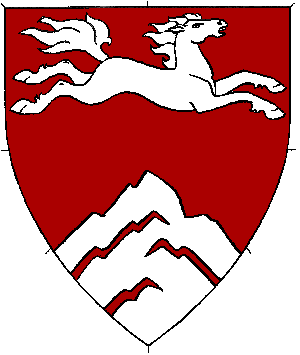1. Angele Marie de Savigny
New name and device submission.
Gyronny sable and Or, a cross crosslet fitched and a bordure counterchanged.
The submitter seeks a feminine name. She does not care about
authenticity and specifies no time or culture. She will allow minor
changes, and in the event of such changes cares most about sound.
Angele can be found in Withycombe as a french
feminine given name s.n. Angela. It is apparently
derived from St Angela (1540). It is also apparently listed in
Dauzat on page 9 as Angèle (we don't have this work).
The accent mark in Dauzat is apparently post period and has been
removed by the college in other registrations c.f. Angele Plaisance
reg'd 04/97.
de Savigny or "of Savigny" can be found in
Reaney & Wilson as a header entry (Savigny) for a french surname.
Dated forms include de Sauenie, de Sauigneo, de Sauigni
from 1086 and de Saueigni from 1196.

2. Colles Ardorum, Shire of
New group name and device submission.
Per pale gules and Or, two dragons combattant and a laurel wreath counterchanged.
The group seeks a name that means "Hill of Flames". They will
allow minor changes and care equally about meaning and sound.
The formation of the name follows a structure "geological feature +
adjective", which is found in several period examples in the Blaeu
Atlas of 1635. [http://www.library.ucla.edu/yrl/reference/maps/blaeu/nameindex-latin.htm,
accessed 3rd June 2006]. It seems likely that this naming pattern was
extant rather earlier than this date. Examples of this pattern include
Alpinæ Fderatæ, Hollandia Australis, Hollandia Borealis,
Rhaetiae Fderatæ, Flandriæ Teutonicæ and Silesiæ
Glogani.
According to the Collins Latin dictionary, Collis is
the Latin word for hill. We believe that Ardorum is
the genitive plural form of Ardor, meaning "heat or
brightness" according to the same source.
The submitter's have included a poll form that satisfies the
requirements of the administrative handbook.
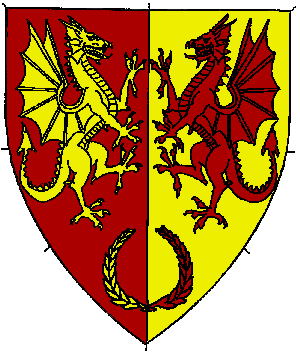
3. Helena Anthony
New name and device submission.
Per fess purpure and azure, on a fess argent three decrescents purpure.
The submitter seeks a feminine name authentic for 12th/13th century
England/France. She will allow minor changes and cares most about
sound.
Helena appears as a header spelling in Withycombe.
The name derives from the Greek and was most commonly rendered as
Ellen in English. Helen and
Helena "came in at the Renaissance". This
is obviously not compatible with the submitter's request for temporal
authenticity, but we feel that changing the name to
Ellen would be too great to regard as a minor
change.
Anthony appears as a header spelling in Reaney and
Wilson s.n. Anthoney, Anthonies, Anthony, Antoney,
Antony. Variants of the name are cited from 1149 through
1306, although none have the desired spelling.
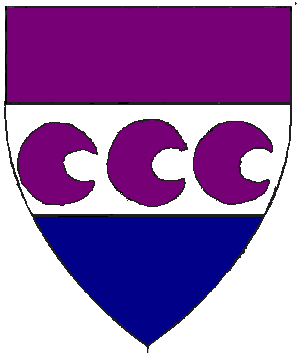
4. Philip de Ravenshagh
New name and device submission.
Per chevron embattled pean and gules, in base a griffin segreant Or.
The submitter seeks a masculine name authentic for 14th century
England. He will accept no changes.
Philip is a header spelling in Withycombe. The name
derives originally from the Greek and is said to have been common in
England during the middle ages. No cited example of the desired
spelling is provided, though Withycombe does discuss the profusion of
spelling variants used, and her list includes that desired.
Ravenshagh is cited in Reaney and Wilson s.n.
Ravenshaw etc. in the instance of one Stephen de
Ravensagh (1332). A variety of later variants of the name are also
cited.
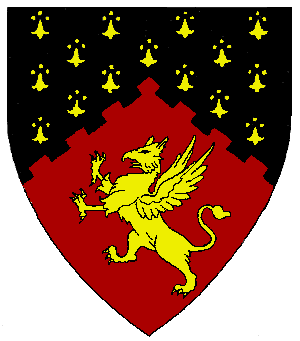
5. Rodry ap Owein
New name and device submission.
Per pale azure and gules, a chevron ermine between three ferrets rampant to sinister argent.
The submitter seeks a masculine name authentic for the Welsh
language/culture. He will allow minor changes and cares most about
language and culture.
The submitted form of the name is "Rhodry", which
according to the submitter appears in Saint Gabriel letter #2799
[www.s-gabriel.org/2799, accessed 21st June 2006]. In fact that
spelling variant does not appear; the letter discusses the forms
Rhodri, Rodri, Rodry and Rudry,
with the variants Rodry or Rodri
cited as most authentic for Welsh use. We have therefore changed the
form of the name to meet the submitter's request for authenticity.
The forms seek the name "Owen" citing Saint Gabriel
report #811 as evidence. Once again, the report does not say what the
submitter says it does. Instead the spelling Owein
is given as the appropriate Welsh form of the name. We have therefore
changed the form of the name to satisfy the submitter's request for
authenticity.
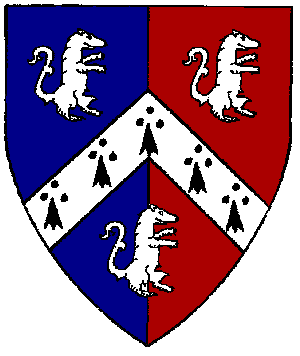
6. Sancha da Sylva
Device resubmission.
Counter-ermine, a dragon segreant ermine.
The submitters orginal device "Per fess indented azure and
counter-ermine" was returned by Laurel in August 2004 LoAR (which
came out Feb 2005) for having a complex line of division between two
low constrast fields.
The submitter's name was registered on the July 2003 LoAR via Caid.
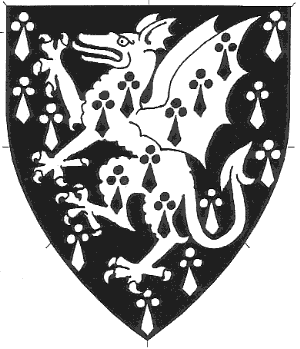
7. Stella de Ravenscar
New name and device submission.
Per bend sable and gules, in bend sinister a ferret and a mullet argent.
The submitter seeks a feminine name authentic for 14th century
England (Yorkshire). She will accept minor changes and in the event
of such changes cares equally about sound and meaning
(Stella = "star", Ravenscar = "Raven's rock").
A medieval use of the name Stella is cited in
Withycombe. The name appears in York's Poll tax records from 1379.
Ekwall lists Ravenscar as a place in the North
riding of Yorkshire. The second element (scar) derives from Old
Scandinavian "Sker", meaning rock. No period citation of the place
name is provided, though there are period citations for other Raven
compounds, such as Ravensdale (1251) and
Ravensden (1180, 1190).
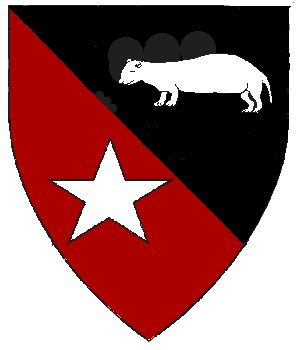
8. Thaddeus Blayney
Device resubmission.
Quarterly vert and sable, a triquetra inverted and an annulet interlaced Or.
The submitter orginally submitted this device in May 2005 and was
returned by Crux for administrative reasons including one form
provided was coloured with markers but the others were very poor
colour photocopies of the one original. The vert on the photocopies
was an odd looking greenish greyish. Secondly there were insufficient
forms provided with only three colour copies given and no black and
white version provided. This submission is free of the previous
problems.
The submitter's name was registered on the September 2005 LoAR.
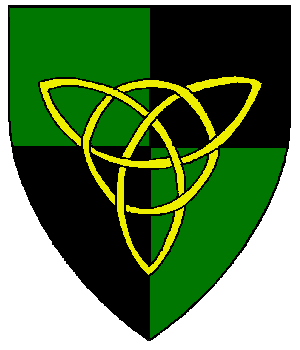
10. Wenefrith Everett de Calabria
New name submission.
The submitter seeks a feminine name authentic for England/Wales of an
unspecified time. She will allow minor changes and expresses no
preferences about the nature of such changes.
Wenefrith is said to be a variant of
Winifred, which appears as a header spelling in
Withycombe. Withycombe does not include the desired spelling, but
does provide other relevant spellings such as
Wynifreed (1585), Winefred
(1631) and Winfrith (1646). The Latin form of the
name is said to be Wenefreda. The submitter would
prefer to use the Latin form of the name if the spelling needs to be
changed.
Everett and Calabria are elements
of the submitter's legal name and she thus wishes to invoke the legal
name allowance. She has provided a copy of her driver's license as
evidence of this fact.
11. Wulfgar jarnsiða
New name and device submission.
Sable, on a bend sinister between two fleur-de-lys argent three dexter gauntlets sable.
The submitter seeks a masculine name authentic for the 9th century
Swedish language and /or culture. He will allow minor changes and in
the event of such changes cares most about sound.
Wulfgar appears as a variant of
Ulfger in Knudsen and Kristensen's
"Danmarks Gamle Personnavne". Dated variants of the name include
Wulfgar (348), Vlfger Vlgrt (228).
Other variants include Wulfgar, Wlgar, Wulger and
Wolfgar.
Járnsíða appears as a byname in Geirr-Bassi. The
name is said to mean "iron-side". The submitter prefers to
omit the accents from the form of his name. Iárnsíða
also occurs in Lind, where it is cited in 1381-2.

12. Ysabeau Angelline de Challon
Change of holding name.
The submitter seeks an feminine name authentic for 16th century France.
She will allow only minor changes.
The submitter previously submitted the name "Ysabeau de Challon",
which was returned on the February 2005 LoAR for aural conflict with
"Isabeau Charron". At that time the holding name
"Ysabeau of Stowe on the Wowld" was registered by
Laurel. She then submitted "Ysabeau Suárez de Challon". This version
of the name, submitted to Crux in August 2005, aimed to clear the
previous conflict through the addition of a name element. Crux pended
the name as the construction could not be documented. Though all of
the elements are consistent with the 16th century, the combination of
the French given name, "Ysabeau", followed by the patronymic Spainish
byname, "Surez", and then Norman French locative "de Challon" was not
likely as a period combination. The submitter has advised in March
2006 that she wished to withdraw the submission at that time to
reconsider her options, which she has now done.
Ysabeau can be found in Tangwystyl verch Morgant
Glasvryn's "Given Names from Brittany, 1384-1600"
[http://www.s-gabriel.org/names/tangwystyl/latebreton/, accessed 10th
June 2006]. The name is a variant of Isabelle cited in 1537.
Angelline may be in "Late Period Feminine Names from
the South of France" by Talan Gwynek
[www.sca.org./heraldry/laurel/names/latefrenchfem.html, accessed 2nd
of June 2006]. It is shown in this form dated to 1528.
Challon may be found in Cateline de la Mor's
"Sixteenth Century Norman Names"
[http://www.s-gabriel.org/names/cateline/norman16.html, accessed 10th
June 2006]. The article lists de Challon as a surname.
As before the addition of the second given name will clear the previous
aural conflict.
